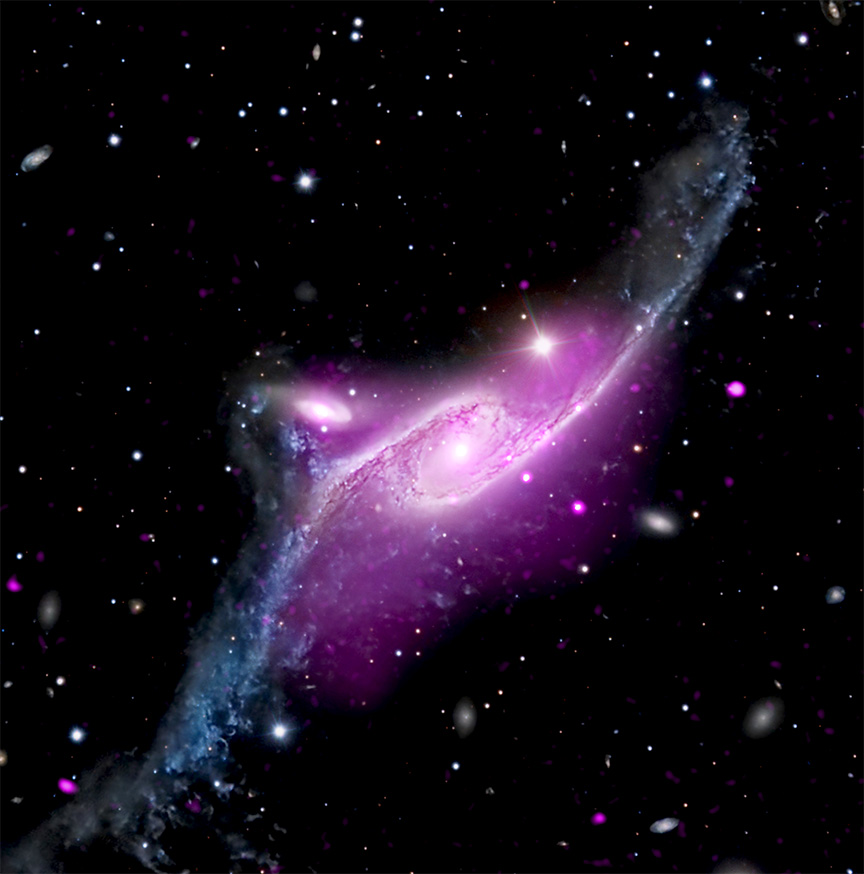 barred spiral galaxy NGC 6872 interacting with a smaller galaxy to the upper left as seen from NASA's Chandra x-ray Observatory
barred spiral galaxy NGC 6872 interacting with a smaller galaxy to the upper left as seen from NASA's Chandra x-ray Observatory barred spiral galaxy NGC 6872 interacting with a smaller galaxy to the upper left as seen from NASA's Chandra x-ray Observatory
barred spiral galaxy NGC 6872 interacting with a smaller galaxy to the upper left as seen from NASA's Chandra x-ray ObservatorySpaceX just stomped the competition for a new contract—that’s not great
NASA wants a “robust” commercial space community. But it has a long way to go.
Excerpt:
There is an emerging truth about NASA’s push toward commercial contracts that is increasingly difficult to escape: Companies not named SpaceX are struggling with NASA’s approach of awarding firm, fixed-price contracts for space services.
.....The recently released source selection statement for the “US Deorbit Vehicle” contract, a process led by NASA head of space operations Ken Bowersox, reveals that the competition was a total stomp. SpaceX faced just a single serious competitor in this process, Northrop Grumman. And in all three categories—price, mission suitability, and past performance—SpaceX significantly outclassed Northrop.
Although it’s wonderful that NASA has an excellent contractor in SpaceX, it’s not healthy in the long term that there are so few credible competitors. Moreover, a careful reading of the source selection statement reveals that NASA had to really work to get a competition at all.
.....A commercial approach generally means that NASA pays a “fixed” price for a service rather than paying a contractor’s costs plus a fee. It also means that NASA hopes to become one of many customers. The idea is that, as the first mover, NASA is helping to stimulate a market by which its fixed-priced contractors can also sell their services to other entities—both private companies and other space agencies.
NASA has since extended this commercial approach to crew, with SpaceX and Boeing winning large contracts in 2014. However, only SpaceX has flown operational astronaut missions, while Boeing remains in the development and test phase, with its ongoing Crew Flight Test. Whereas SpaceX has sold half a dozen private crewed missions on Dragon, Boeing has yet to announce any.
.....Some of NASA’s most important traditional space contractors, including Lockheed Martin, Boeing, and Northrop Grumman, have all said they are reconsidering whether to participate in fixed-price contract competitions in the future. For example, Northrop CEO Kathy Warden said last August, “We are being even more disciplined moving forward in ensuring that we work with the government to have the appropriate use of fixed-price contracts.”
So the large traditional space contractors don’t like fixed-price contracts, and many new space companies are struggling to survive in this environment.
The US Deorbit Vehicle offered an interesting test case for how NASA would approach commercial contracts given all of the above. This mission required a spacecraft capable of docking with the International Space Station, remaining attached for about a year, and then powering the large station down through the Earth’s atmosphere, where it could make a controlled descent into the ocean. This, NASA determined, was the safest way to dispose of the aging station after more than 30 years of operations.
While there were myriad potential solutions, it seemed clear that SpaceX, with Dragon, and Northrop Grumman, having acquired Orbital Sciences and the Cygnus spacecraft, were the clear favorites. What happened next is telling. I have pieced the following together from the source selection statement, publicly available documents, and on-background interviews with a handful of key officials.
Initially, within the International Space Station program, the expectation was that a deorbit mission would cost less than $1 billion. However, the agency’s Office of the Chief Financial Officer later estimated it might cost as much as $1.7 billion. This prompted NASA to ask the Office of Management and Budget for $1.5 billion for the program.
.....Certainly, this is not attributable to favoritism—indeed, NASA would prefer not to be beholden to a single contractor, however excellent its present performance and price may be. SpaceX, rather, is winning because it is often the best and sometimes only option for the government.
Notably, the initial draft “request for proposals” for a deorbit mission issued in May 2023 called for a “single-award Hybrid Cost-Plus Incentive Fee and Firm Fixed Price core” contract. However, four months later, in its final request for proposals, NASA said it wanted to maximize competition. Companies, therefore, could propose contracts that were either largely based on cost-plus or fixed-price.
Essentially, Northrop told NASA it would not bid for a firm, fixed-priced contract. And conversely, SpaceX said it would not bid under a cost-plus contracting mechanism, which would require the company to add a new layer of bureaucracy to process such contracts. .....
SpaceX’s bid price was $680 million. The source selection statement did not reveal a price for Northrop’s bid other than saying it was “significantly higher.” Based on NASA’s budget request, Northrop’s bid was likely approximately twice as high.
But SpaceX did not just win on price. Its “mission suitability” score, effectively its technical ability to design, develop, and fly a vehicle capable of deorbiting the space station, was 822, compared to Northrop’s score of 589. SpaceX’s approach had one weakness, compared to seven weaknesses in Northrop’s bid, according to NASA evaluators.
Finally, the selection was also based on past performance by the contractors. SpaceX’s performance was rated as “very high,” given how it has delivered with the Cargo and Crew Dragon spacecraft and its Falcon 9 rocket. Northrop’s performance on Cygnus and its various rockets was given a “moderate” rating. Overall, the NASA evaluators expressed a “very high level” of confidence in SpaceX being able to complete the mission, whereas a “moderate level” of confidence was expressed in Northrop.
.....This really is the point. In this competition, for which NASA expressly wanted multiple bidders from its “robust contractor community,” the agency had to bend over backward from a contracting standpoint to get two entrants. And when the competition unfolded, it was not even close: SpaceX had the far lower bid, with a far higher chance of success.
......only one company—SpaceX—is thriving in NASA’s commercial space ecosystem.
That is not a great position for the space agency to find itself in, so there are plenty of questions for NASA and policymakers. Do they cave to traditional space contractors and go back to cost-plus contracts for most services? (Slow and expensive.) Do they turn over many of their spaceflight functions to SpaceX? (Not desirable or politically practical.) Do they continue to hope and wait for other companies to make the next step? (The early returns are not great.)
The push toward commercial space seems admirable. But NASA needs a strategy, likely involving fewer requirements and more financial support, to help us get there.

 Eskifjörður, Iceland
Eskifjörður, Iceland